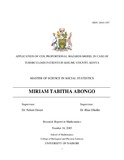| dc.description.abstract | Tuberculosis (TB) remains a major global health problem. In 2013, World Health Organization
estimated 8.6 million people to have developed TB and 1.3 million died from the disease
including 320 000 deaths among HIV-positive people. Kenya is ranked 15th up from 13th
position among the 22 high TB burden countries worldwide which contributes 80% of the global
TB. The main objective of this study was to describe the pattern of time of treatment interruption
in TB patients in Kisumu County Kenya. The specific objectives were to compare Survival
functions for two groups of Tuberculosis patients and identify significant predictors of loss to
follow-up (LTFU) among the TB patients. This was a retrospective cohort study based on TB
patients that were registered in the unit TB registers. Kisumu County was randomly sampled for
the study from the top ten high TB burden counties in Kenya; Secondary data was collected from
documents of all TB cases registered from January to December 2013 in the health facilities.
This study focused on time of loss to follow-up for TB patients enrolled on treatment in the
health facilities. Kaplan-Meir estimator and Cox proportional hazard model have been used for
the analysis and model building. Logrank tests and Wilcoxon tests were used for comparison of
survival data. Cox model was able to provide the estimates covariates and their effect on loss to
follow-up of Tuberculosis patients after adjustment for other explanatory variables. From the
1,275 patients in this study a total of 107(8.4%) interrupted treatment and 1,168 (91.6%) were
censored. The median time of treatment interruption was 2.167 months (65 days).This analysis
shows that most of the Tuberculosis patients are lost to follow up during the intensive phase of
treatment which is within the first two months. The Log rank and Wilcoxon test were not
significant in LTFU survival experience between the various categories for covariates HIV
status, weight, gender and type of TB at alpha significance level of 5% (p<0.05). We find
significant differences in survival experience of the patients in different categories of age;
patients with more than 35 years of age had better survival rates compared to those who were
younger. Results of the proportional hazards Cox regression analysis of TB patients revealed that
the covariates age, weight and Tuberculosis patient type were significant factors associated with
treatment interruption for TB patients. There is need to strengthen follow up of patients on TB
treatment especially during the intensive phase and until completion of treatment. | en_US |

